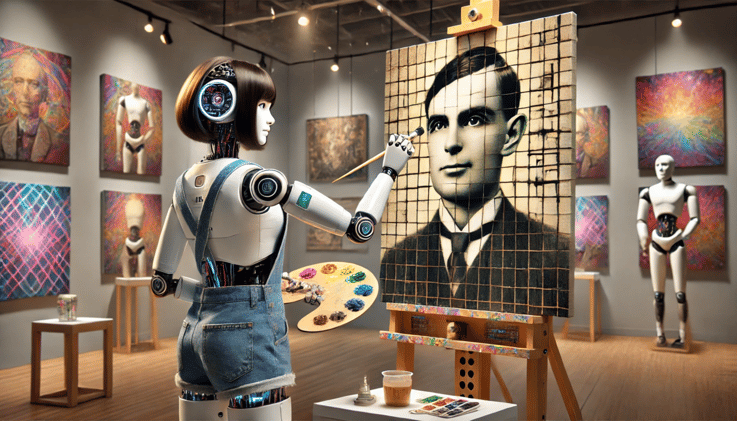Landmark Moment: Humanoid Robot Ai-Da’s Alan Turing Portrait Sells for Over $1 Million
In a groundbreaking achievement that highlights the intersection of art and technology, a portrait of Alan Turing created by Ai-Da Robot—a humanoid artist robot—has sold at auction for an astonishing $1,084,800 (£836,667). This sale marks a significant milestone in the contemporary art world, as it is the first time a humanoid robot artist has achieved such a high valuation.
The Historic Sale
Titled ‘A.I. God. Portrait of Alan Turing (2024),’ the portrait was initially estimated to sell for between $120,000 and $180,000. However, intense interest from bidders led to 27 bids, ultimately culminating in a final sale price that greatly exceeded initial estimates.
The Significance of the Auction
Sotheby’s described the sale as ‘a new frontier in the global art market,’ setting a benchmark for artworks created by humanoid robots. The portrait was purchased by an undisclosed buyer, underscoring the rising value and intrigue surrounding AI-generated art.
About Alan Turing and His Influence on AI
Alan Turing, the subject of Ai-Da’s artwork, was a mathematician and codebreaker who played a critical role in World War II by helping to crack the Enigma code. Often regarded as the father of artificial intelligence, Turing’s pioneering work laid the groundwork for modern computing and AI. His legacy resonates strongly in the tech world, particularly as AI continues to expand its influence across industries.
Ai-Da Robot: The Artist and Her Vision
Ai-Da Robot, equipped with an advanced AI language model, uses cameras in her eyes and robotic arms to paint and draw. Typically seen wearing a dark wig and denim overalls, Ai-Da is an artist ‘in her own right,’ according to Meller. Commenting on her work, Ai-Da stated:
"The key value of my work is its capacity to serve as a catalyst for dialogue about emerging technologies."
Her portrait of Turing, in particular, ‘invites viewers to reflect on the god-like nature of AI and computing while considering the ethical and societal implications of these advancements.’ Ai-Da’s portrayal of Turing captures his forward-thinking vision, as he ‘stares at us, as we race towards this future.’
The Limitations of Ai-Da’s Creativity
While Ai-Da’s artwork has achieved high valuation, it is essential to note that her creative process differs significantly from human artists. Her ability to create art is based on algorithms and programming, rather than subjective experience or intuition.
Meller believes that Ai-Da’s art challenges viewers in a way similar to how 20th-century artist Marcel Duchamp changed perceptions of art.
"What it means to be a human is changing, whether we like it or not, and this is perhaps why Ai-Da has proved so disturbing," Meller explained. "She is reflecting this change, perhaps rather unsubtly."
ChatGPT’s Thoughts on the Sale
"This milestone is both exciting and thought-provoking. Ai-Da’s work selling for over $1 million represents a convergence of AI, art, and human curiosity, blurring the boundaries between machine creativity and human-driven artistry.
The fact that a robot not only creates art but also draws high demand and value raises questions about authorship, value, and even agency in the art world. It’s fascinating (and perhaps a little unsettling) to consider that Ai-Da’s artistic success challenges traditional views of what it means to be an artist."
Reflecting on the AI-Art Milestone
The success of Ai-Da’s portrait highlights the evolving role of AI in artistic creation, bringing new dimensions to questions of authorship, identity, and agency in art. With AI-driven art now achieving high valuation at top auction houses, Ai-Da’s success may signal the start of a new era in which AI-created works play a more substantial role in the global art market.
For artists, collectors, and tech enthusiasts alike, Ai-Da’s breakthrough auction brings attention to the potential—and the complex questions—that AI presents for the future of creativity.

